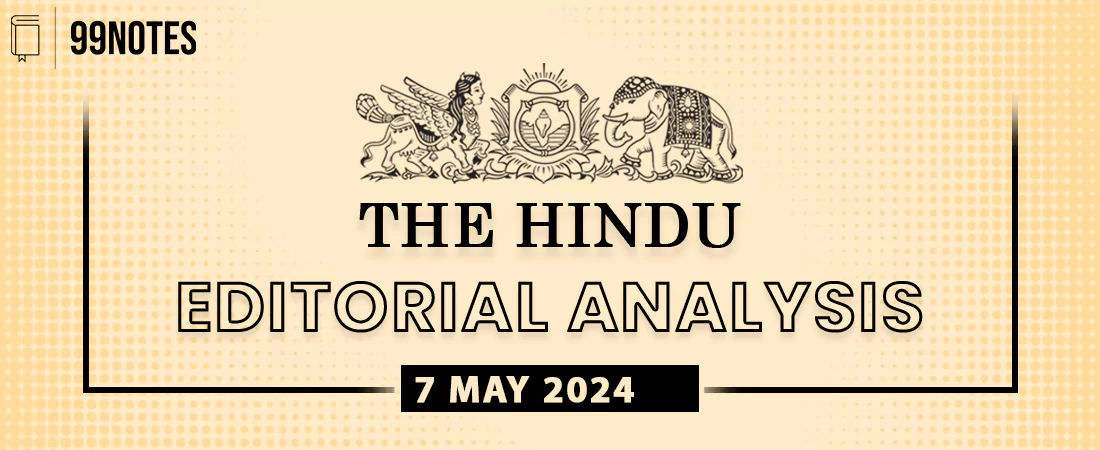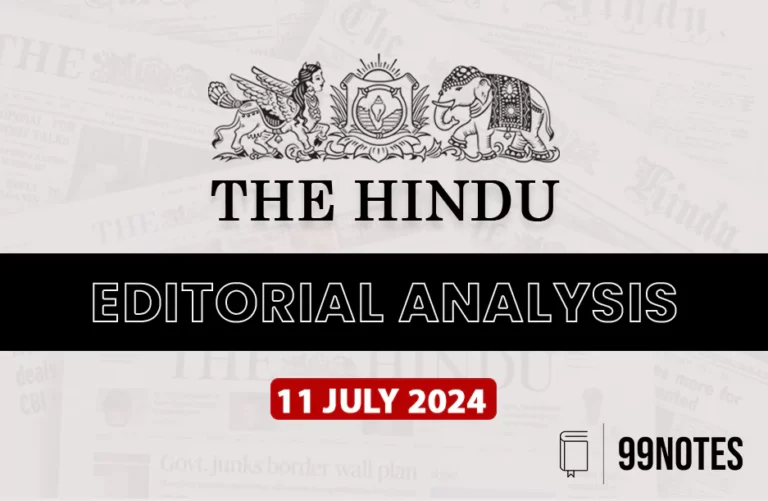7 May 2024 : The Hindu Editorial Notes PDF
1. A half-hearted climate change verdict
| Topic: GS2 – Indian Polity – Judiciary
GS3 – Environment – Environmental pollution and degradation |
| Context: |
| ● In a landmark decision, the Supreme Court of India extends constitutional rights to include protection from climate change impacts, offering hope amidst global inaction.
● The potential of this Supreme Court judgement to redirect India towards sustainable and just climate action is emphasised. ● While recognizing the disproportionate impact on marginalised communities, the judgement’s flaws in rapid energy transition are highlighted in the following article. |
Introduction: The Supreme Court’s Climate Rights Ruling
- The Supreme Court of India has extended constitutional rights to life and equality to include protection from the ill-effects of climate change, offering a glimmer of hope in a dire ecological situation.
- Despite governments worldwide failing to act on scientific evidence, the judgement holds promise in addressing climate crisis impacts, especially on marginalised communities.
| What are the arguments put forth by the Supreme Court in the judgement? |
| ● Recognition of Climate Change Impacts: The Supreme Court recognized the adverse impacts of climate change, linking them with fundamental rights.
● Interpretation of Constitutional Provisions: It interpreted Articles 48A, 51A(g), and 21 of the Constitution, emphasising the duty to protect the environment and the right to life. ● Judicial Precedents: The court cited past judgments, such as MC Mehta vs Kamal Nath (2000) and Virender Gaur vs State of Haryana (1995), recognizing environmental protection as integral to fundamental rights. ● Threat to Right to Life and Equality: Climate change-induced disruptions were seen as jeopardising the right to life and equality, especially for vulnerable communities. ● International Obligations: The judgement aligned with international human rights principles, acknowledging states’ obligations to prevent harm caused by climate change. ● Role of Legal Framework: It highlighted the absence of an umbrella legislation on climate change in India despite existing environmental protection laws. ● Need for Articulation of Rights: The court stressed the necessity to articulate the right against adverse climate change effects, considering its impact on various constitutional rights. ● Intersection of Environmental Protection and Human Rights: The judgement underscored the intrinsic connection between environmental protection, climate change, and human rights, emphasising the need for effective laws and policies to mitigate climate impacts. |
Significance of the Judgment
- The Court’s decision has the potential to translate into actions mitigating climate crisis impacts and facilitating adaptation, particularly given its recognition of the disproportionate burden borne by marginalised groups.
- However, flaws in the judgement risk undermining its positive potential, notably concerning energy transition strategies and their environmental impacts.
Flaws in the Judgment
- The Court emphasises the importance of solar and wind power to meet India’s climate commitments but fails to address problematic aspects of the proposed energy transition.
- The inclusion of large hydropower and nuclear plants under ‘non-fossil-fuel’ and ‘renewable’ energy categories overlooks their adverse effects, such as biodiversity loss and displacement of communities.
- Mega-solar and wind projects have significant adverse impacts, including land displacement and destruction of ecosystems, yet they are exempt from environmental impact assessments.
- Despite renewable energy investments, the government continues to approve new coal mining blocks, undermining climate goals and impacting biologically diverse areas, often at the expense of indigenous communities.
Lack of Consideration for Alternatives
- The Court’s acceptance of the energy transition overlooks alternatives like decentralised renewable energy sources, which could address energy needs while minimising environmental impact.
- Questions regarding energy wastage, inefficient transmission, and luxury consumption are not addressed, neglecting potential solutions like demand management and power redistribution.
- The Court disregards emerging global jurisprudence, including the rights of nature and indigenous peoples, which could inform more just climate actions and project assessments.
Expanding the Positive Potential
- The Court could enhance the judgement’s positive impact by tasking its expert committee to explore less damaging energy generation alternatives and non-electric means of meeting energy demand.
- Additionally, the Court should consider broader issues of development models that violate constitutional rights, directing the government to re-examine projects causing deforestation and displacement, in line with protecting indigenous communities’ traditional ways of life.
Conclusion: Realigning Climate Rights
- The Supreme Court’s ruling offers hope in addressing climate crisis impacts but requires critical examination and action to fulfill its potential.
- By addressing the flaws and expanding considerations for alternatives and indigenous rights, the Court can steer India towards a more sustainable and just approach to climate action.
| PYQ:
Q.1 Discuss global warming and mention its effects on the global climate. Explain the control measures to bring down the level of greenhouse gases which cause global warming, in the light of the Kyoto Protocol, 1997. (UPSC CSE (M) GS-3 2022) Q.2 Describe the major outcomes of the 26th session of the Conference of the Parties (COP) to the United Nations Framework Convention on Climate Change (UNFCCC). What are the commitments made by India in this conference? |
| Practice Question: Discuss the significance of the Supreme Court of India’s recent ruling extending constitutional rights to encompass protection from climate change impacts. Evaluate the potential implications of the judgement’s flaws in overseeing the country’s energy transition strategies. (250 Words /15 marks) |
2. India’s press freedom has rapidly declined in recent years
| Topic: GS2 – Governance |
| Context: |
| ● The 2024 press freedom index places India at 159 out of 180 nations, showing a slight improvement but reflecting long-standing issues.
● Comparisons with other nations, trends in press freedom, and global developments highlight ongoing challenges and occasional improvements in media freedom worldwide. |
India’s Press Freedom Ranking
- India is ranked 159 out of 180 nations in the 2024 press freedom index by Reporters Without Borders.
- This marks a slight improvement from the previous year but reflects a longstanding issue, with India ranking over 100 since 2003.
- Despite marginal progress, India’s press freedom remains consistently poor, with recent years witnessing a rapid erosion.
| More About World Press Freedom Index |
| World Press Freedom Index:
● The World Press Freedom Index ranks countries annually based on the level of freedom available to journalists. ● Developed by Reporters Without Borders (RSF), it evaluates pluralism, media independence, environment, self-censorship, legislative framework, transparency, and abuses. ● Scores range from 0 (best) to 100 (worst), with higher scores indicating more freedom. ● Nordic countries like Norway, Finland, Sweden, consistently rank highest due to robust legal protections and media independence. ● Countries with authoritarian regimes often rank lowest, with North Korea, Turkmenistan, and Eritrea frequently at the bottom. ● Factors influencing rankings include government censorship, intimidation, violence against journalists, and internet restrictions. About Reporters Without Borders: ● Reporters Without Borders (RSF) is a non-profit organization advocating for freedom of the press and journalists’ rights globally. ● Founded in 1985 in Montpellier, France, RSF has consultative status at the United Nations and UNESCO. ● The organization provides support and legal assistance to journalists facing threats, imprisonment, or censorship. ● RSF campaigns against censorship, digital surveillance, and attacks on journalists worldwide. ● They operate on the principles of independence, impartiality, and neutrality. ● RSF conducts advocacy efforts, raising awareness about press freedom violations and advocating for the release of imprisoned journalists. ● The organisation relies on donations and grants to fund its activities. ● RSF has regional offices in various countries, working directly with local journalists and organisations. ● They engage in legal battles and lobbying efforts to promote and protect press freedom internationally. |
Comparison with Other Nations
- India’s press freedom ranking is comparable to that of territories like the occupied Palestinian territories, authoritarian regimes like Russia, flawed democracies like Turkey, and absolute monarchies like the UAE.
- Scandinavian countries like Norway, Denmark, and Sweden continue to lead in press freedom, while Eritrea, Syria, and Afghanistan rank among the worst performers.
- Among BRICS nations, Brazil and South Africa fare better than India, while China and Russia rank lower. In South Asia, except for Bangladesh, all neighbouring countries surpass India in press freedom.
Trends in Press Freedom
- While India’s press freedom has declined in recent years, the trend is mirrored in many other nations. However, some countries have shown significant improvements.
- Bhutan witnessed the largest decline in press freedom rankings from 2019 to 2024, followed by Hong Kong and Afghanistan. Conversely, the Central African Republic, Timor-Leste, and Montenegro saw substantial improvements.
Global Developments
- Italy and Argentina have experienced declines in press freedom rankings in the past five years. Notably, Argentina’s closure of the public press agency Telam is criticized as a concerning symbolic act.
- Greece faces criticism for its handling of a wiretapping scandal involving journalists and the murder of a veteran crime reporter in 2021.
- The Wall Street Journal’s decision to relocate its Asia headquarters from Hong Kong to Singapore reflects concerns over Hong Kong’s national security law, which critics argue curtails freedoms.
- Al Jazeera’s shutdown in Israel underscores a decline in press freedom, with Israel’s ranking dropping from 88 to 101. The move is denounced by Al Jazeera as “criminal.”
Conclusion: Press Freedom in Global Context
- Despite slight improvements, India’s press freedom ranking remains unsatisfactory, echoing persistent concerns.
- The global landscape presents a varied scenario, with shifts in press freedom observed across nations.
- Ongoing developments underscore the complex challenges faced by media freedom, requiring continued vigilance and efforts to safeguard journalistic independence.
| Press Freedom Threats & Impacts |
| Threats to Press Freedom in India:
● Political Interference: Government attempts to control media narratives through intimidation and regulation. ● Violence against Journalists: Attacks on journalists by state and non-state actors hinder their ability to report freely. ● Legal Challenges: Laws like sedition and defamation are often misused to suppress dissent and investigative journalism. ● Economic Pressures: Media ownership by corporations or political entities leads to self-censorship to protect interests. Impact: ● Diminished Democracy: Free press is essential for holding power accountable and informing citizens. ● Undermined Transparency: Without independent journalism, corruption and injustices can go unchecked. ● Threat to Human Rights: Suppressed media limits exposure of human rights violations and impedes advocacy efforts. Way Forward: ● Legal Reforms: Amend laws to safeguard journalistic freedom and prevent misuse. ● Journalist Protection: Ensure safety through legal and physical protection measures. ● Public Awareness: Educate citizens on the importance of a free press in democracy. ● Media Pluralism: Encourage diverse ownership and funding models to reduce susceptibility to control. |
| PYQ: What do you understand about the concept “freedom of speech and expression”? Does it cover hate speech also? Why do the films in India stand on a slightly different plane from other forms of expression? Discuss. (200 words/12.5m) (UPSC CSE (M) GS-2 2014) |
| Practice Question: Examine India’s ranking in the 2024 press freedom index and discuss its implications in the global context of media freedom. (150 Words /10 marks) |







